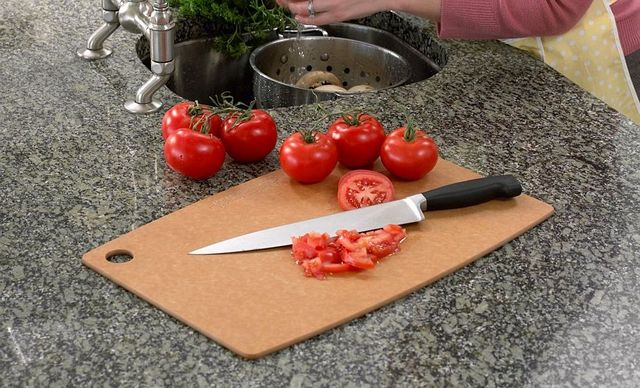 The wood fibers are layered and pressed into a food-safe resin which makes the board pretty dense and surprisingly heavy (the 14.5-in by 11.25-in board is about 1.5 pounds). After over six years of use, all my boards (which I purchased from Bed Bath & Beyond and Amazon.com
The wood fibers are layered and pressed into a food-safe resin which makes the board pretty dense and surprisingly heavy (the 14.5-in by 11.25-in board is about 1.5 pounds). After over six years of use, all my boards (which I purchased from Bed Bath & Beyond and Amazon.com The wood fibers are layered and pressed into a food-safe resin which makes the board pretty dense and surprisingly heavy (the 14.5-in by 11.25-in board is about 1.5 pounds). After over six years of use, all my boards (which I purchased from Bed Bath & Beyond and Amazon.com
The wood fibers are layered and pressed into a food-safe resin which makes the board pretty dense and surprisingly heavy (the 14.5-in by 11.25-in board is about 1.5 pounds). After over six years of use, all my boards (which I purchased from Bed Bath & Beyond and Amazon.com
- Do you know if they are harder on knives than normal wood? I have touched som boards in a store, and had the feeling that they are much harder. They also contain a lot of glue, to my understanding, that some say is harsh on the edge of the knife.
- Have your tried the black ones? They have another composition, I think.
- It seems, a big brand is TopChef, making optical identical boards, somewhat cheaper. Have your tried them?
- Do you know if they have the same anti-bacterial properties as wood? This is the main reason I use wood for chicken and meat.
I don't know if they are harder on knives than normal wood. They do not seem to be. I have not found that I have needed to sharpen my knives any more often than when I was using regular wood. (So, if they are harder, then it is by a negligible amount.)
I own both black and natural (two boards of each). They might have different composition, but I have not noticed a significant difference between the boards. I really can't say if one is softer than the other from my experience.
I have not had an opportunity to try similar boards from TopChef.
I do not know for sure, but they do seem to clean easily and once dry do not appear to harbor any bacteria. They do have the added benefit that you can run them in a dishwasher which will usually be sufficient to sanitize the board if there is any doubt. I am a stickler for food safety in my house and have used my boards (except the small one) on meat and poultry for years now without incident. I don't know if this is useful information or not to you, but these boards are NSF certified.